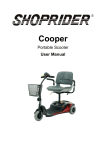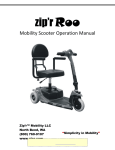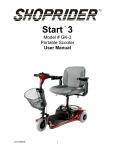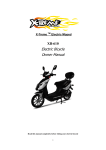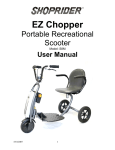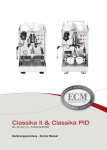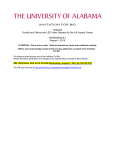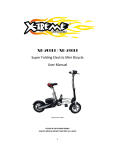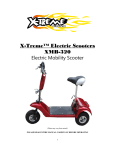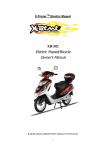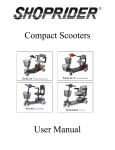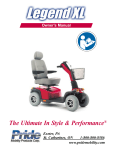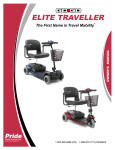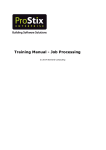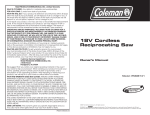Download XMB-400 Owner`s Manual
Transcript
X-Treme™ Electric Scooters XMB-400 Electric Mobility Scooter Owner’s Manual (Photo may vary from actual) PLEASE READ ENTIRE MANUAL COMPLETELY BEFORE RIDING 1 IMPORTANT! BATTERY MAINTENANCE and CHARGING INSTRUCTIONS 1. You MUST charge completely prior to initial use. (Follow charging instructions in your Product Handbook) 2. Charge immediately after each use. 3. Charge before storage. You must charge every 30 days if not in use. 4. Charge the unit for 10-12 hours or until the light on the charger turns green. 5. DO NOT allow this unit to deep discharge the battery. 6. For safety purposes, DO NOT charge for over 12 hours. 7. Turn the unit OFF when not in use. Failure to follow these INSTRUCTIONS will VOID YOUR WARRANTY! THIS PRODUCT IS NOT INTENDED FOR EXTREME or OFF-ROAD USE! Please take care of your scooter! DO NOT JUMP or ABUSE THIS PRODUCT! DO NOT RIDE IN WET/ICY CONDITIONS! Failure to follow these instructions will VOID YOUR WARRANTY 2 IMPORTANT PLEASE READ THIS BEFORE USING THIS PRODUCT WARNING This product does not conform to Federal Motor Vehicle Standards and is not intended for operation on public streets, roads or highways. Serious injury can result from the unsafe operations of this product. Operator can minimize these risks by using certain safety equipment such as: safety helmet, goggles, gloves, elbow and kneepads and appropriate footwear. DO NOT operate this product in traffic, on wet, frozen, oily or unpaved surfaces or under the influence of drugs and/or alcohol. Avoid uneven surfaces, potholes, surface cracks and obstacles. DO NOT use a water hose to clean this product. See Product Handbook for more information. This product is recommended for riders 16 YEARS OF AGE and older. SAFETY Persons without excellent vision, balance, coordination, reflex, muscle and bone strength and good decision-making capabilities should not use this product. Minors without adult supervision should not use this product. Persons unwilling or unable to take responsibility for their own actions should not use this product. The user of this product assumes ALL risks associated with its use. To minimize these RISKS, the user must wear safety helmet, goggles, gloves, elbow and kneepads and appropriate footwear. This product is ELECTRIC! DO NOT ride this product in wet conditions, puddles or rainy weather. 3 QUICK REFERENCE SAFETY GUIDE SAFETY GUIDE The recommended minimum age for riding this scooter is 16 years old. To avoid damage to the motor and footplate, do not overload the scooter. Never ride with more than one person. Inspect your scooter thoroughly before each use for loose or missing parts. Avoid unintentional starts by turning the scooter off while not in use. To avoid the risk of a short circuit in the electrical parts, do not use your Electric scooter in the rain and never spray or wash off your scooter with water. Do not place the battery near fire or heat. To avoid damage to the battery, do not use the charger if it has been damaged in any way. Keep hands, face, feet and hair away from all moving parts. Do not touch the motor or wheels while they are rotating. Brakes are designed to control speed as well as stop the scooter. Practice braking for proper slowing down and smooth stops. Maintain your scooter as recommended in this Product Handbook. Use only quality replacement parts as recommended by the manufacturer. Inspect the entire scooter prior to each use. Replace any part that is cracked, chipped or damaged before use. *NEVER ALLOW CHILDREN TO OPERATE THE SCOOTER WITHOUT ADULT SUPERVISION. *NEVER ATTEMPT TO OPERATE THE SCOOTER WHILE UNDER THE INFLUENCE OF ALCOHOL. If a situation arises that is not covered in the manual, proceed with caution and use good judgment. 4 DO NOT RETURN TO STORE! Do not use this vehicle for the first time until you have inflated the tires to the correct PSI and completely charged the battery. Failure to follow these instructions may damage your vehicle and void your warranty. For technical support CALL OR GO ONLINE 1-253-777-0690 www.x-tremescooters.com/support/ 5 TABLE OF CONTENTS Important – Battery Maintenance & Charging Instructions…………………………………… 2 Important – Warning & Safety………………………………………………………………….. 3 Quick Reference Safety Guide…………………………………………………………………. 4 Technical Support Information………………………………………………………………….. 5 Table of Contents………………………………………………………………………………… 6-7 Riding Safety…………………………………………………………………………………….. 8-10 Safety Basics: Do’s & Don’ts………………………………………………………….. 8-9 Operating Reminders and Suggestions………………………………………………. 9 Wet Weather Riding……………………………………………………………………. 9-10 Night Riding……………………………………………………………………………… 10 Other Reminders……………………………………………………………………….. 10 Introduction………………………………………………………………………………………. 11 Specifications & Structure………………………………………………………………………. 12-14 Tiller Console……………………………………………………………………………. 12 Charging and Control System…………………………………………………………. 13 Seat Unit………………………………………………………………………………….. 13 Specifications……………………………………………………………………………. 14 Assembly………………………………………………………………………………………….. 15-16 Getting Started…………………………………………………………………………… 15 Adjusting the Tiller………………………………………………………………………. 15 Assembling the Seat Post………………………………………………………………. 15 Assembling the Battery Unit…………………………………………………………….. 16 Assembling the Seat Unit……………………………………………………………….. 16 Assembling the Carrier Basket…………………………………………………………. 16 Disassembly……………………………………………………………………………………… 17 Comfortable Adjusting…………………………………………………………………………… 18 Seat Height Adjustment………………………………………………………………… 18 Seat Rotation…………………………………………………………………………….. 18 Armrest Width Adjustment……………………………………………………………… 18 Tiller Angle Adjustment…………………………………………………………………. 18 Operation…………………………………………………………………………………………. 19-21 Tiller Console…………………………………………………………………………….. 19 Power Switch…………………………………………………………………………….. 19 Throttle Control Lever……………………………………………………………………. 19 Speed Adjustment Knob………………………………………………………………… 19 Battery Condition Indicator……………………………………………………………… 19-20 Horn Button……………………………………………………………………………… 20 Head Light Button………………………………………………………………………. 20 Battery Charger…………………………………………………………………………. 20 Load Protector…………………………………………………………………………… 20 Manual Free-Wheel Mode Lever………………………………………………………. 20-21 3-Pin Charger Power Receptacle……………………………………………………… 21 Battery & Charging……………………………………………………………………………….. 22-24 Charging Your Batteries………………………………………………………………… 22 New Battery’s Usage…………………………………………………………………… 22-23 6 Frequently Asked Questions (FAQ)…………………………………………………… 23-24 Care & Maintenance…………………………………………………………………………….. 25-27 Moisture………………………………………………………………………………….. 25 Temperature…………………………………………………………………………….. 25 General Guidelines……………………………………………………………………… 25-26 Sleep Timer……………………………………………………………………………… 26 Daily Checklist………………………………………………………………………….. 26 Weekly Checklist………………………………………………………………………… 26 Storage…………………………………………………………………………………… 26 Cleaning…………………………………………………………………………………. 26-27 Safety…………………………………………………………………………………………….. 28-31 Pre-Ride Checklist………………………………………………………………………. 28 Weight Limitations………………………………………………………………………. 28 Incline Information……………………………………………………………………….. 28 Braking Information……………………………………………………………………… 29 Outdoor Driving Surfaces………………………………………………………………. 29 Free-Wheel Mode……………………………………………………………………….. 29 Stationary Obstacles (Steps, Curbs, Etc.)…………………………………………….. 29 Streets and Roadways………………………………………………………………….. 29 In or Out Doors………………………………………………………………………….. 29 Up or Down Stairs and Escalators…………………………………………………….. 30 In or Out Elevators………………………………………………………………………. 30 Electromagnetic Interference…………………………………………………………… 30 Scooter Transport………………………………………………………………………. 30 Seat Belt…………………………………………………………………………………. 30 Inclement Weather Precautions………………………………………………………… 30 Getting Onto or Off Your Scooter……………………………………………………… 31 Balance………………………………………………………………………………….. 31 Preventing Unintended Movement…………………………………………………….. 31 Limitation to Medicine(s) and Alcohol………………………………………………….. 31 Electromagnetic Interference……………………………………………………………………. 32-33 EMI/RFI Warnings………………………………………………………………………. 32 Where Do Radio Waves Come From?.................................................................... 32 How Can I Expect My Scooter To Move If EMI Affects It?....................................... 32 Are All Electric Mobility Vehicles Susceptible to EMI?............................................. 32-33 How To Prevent EMI……………………………………………………………………. 33 7 RIDING SAFETY Like any sport, cycling carries the risk of injury and damage. By choosing to ride the XMB-400, you assume all responsibility for these risks. Thus, you need to know and practice the rules of safe and responsible riding. YOUR INSURANCE POLICIES MAY NOT PROVIDE COVERAGE FOR ACCIDENTS INVOLVING THE USE OF THIS CYCLE. TO DETERMINE IF COVERAGE IS PROVIDED YOU SHOULD CONTACT YOUR INSURANCE COMPANY OR AGENT. Safety Basics: Do’s and Don’ts The Do’s o Always conduct a Safety Check before you ride your XMB-400. Be thoroughly familiar with the controls of your XMB-400. o Always wear an approved helmet when riding your XMB-400. Follow the helmet manufacturer’s instructions for fit, use and care of your helmet. o Always keep body parts and other objects away from the spinning wheels of your XMB-400. o Always wear shoes that will stay on your feet and will stay on the floorboard. o Wear bright, visible clothing that is not so loose that it can catch on moving parts of the XMB-400 or objects at the side of the road or trail. o Think about your speed, and keep your speed consistent with safe operating conditions. The Don’ts o Never ride with headphones. They mask traffic sounds, distract you from concentrating on your surroundings, and their wires can tangle in the moving parts of the XMB-400, causing you to lose control. o Never carry a passenger. The maximum carrying capacity is 240 lbs. o Never ride barefoot or wearing sandals. o Don’t jump with your XMB-400. It puts great stress on everything from frame and forks to drive train. Riders who jumping their XMB-400 risk serious damage to their XMB-400 and will void their warranty. o Never carry anything which obstructs your vision or your complete control of the XMB-400 or which could become entangled in the moving parts of the XMB-400. o Never hitch a ride by holding on to another vehicle. o Never ride your XMB-400 while under the influence of alcohol or other drugs. o If possible, avoid riding in bad weather, when visibility is obscured, at dusk or in the dark, or when you are very tired. Each of these conditions increases the risk of accident. 8 o Never allow children to ride. Never allow others to ride without reading and understanding these instructions. Operating Reminders and Suggestions o Review all instructions carefully before riding the XMB-400. o Follow all rules and regulations in your area for operating a motorized scooter. Obey the same road laws as all other road vehicles, including yielding the right-of-way to pedestrians, and stopping at red lights and stop signs. o Ride predictably and in a straight line. Never ride against traffic. o Use the signal lights to indicate turning or stopping. o Ride defensively. To other road users, you may be hard to see. o Concentrate on the path ahead. Avoid potholes, gravel and dirt, wet road, oil, curbs, speed bumps, drain grates and other obstacles. o Be alert for unexpected events, such as opening car doors or cars backing out of concealed driveways. o Be extra careful at intersections and when preparing to pass other vehicles. o Familiarize yourself with all the bike's features. Practice signal lights, braking and use of the horn. o Don't carry packages or passengers that will interfere with your visibility or control of the bike. o Don't use items that may restrict your hearing. o Maintain a comfortable stopping distance from all other riders, vehicles and objects. Safe braking distance and forces are subject to the prevailing weather and road conditions. Wet Weather Riding Wet weather impairs traction, braking and visibility, both for the rider and for other vehicles sharing the road. The risk of accident is dramatically increased in wet conditions. In wet weather you need to take extra care. In wet conditions, the stopping power of your brakes (as well as the brakes of other vehicles sharing the road) is dramatically reduced. This makes it harder to control speed and easier to lose control. To make sure that you can slow down and stop safely in wet conditions, apply your brakes earlier and more gradually than you would under normal, dry conditions. Decrease your riding speed, avoid sudden braking, and take corners with additional caution. Keep in mind that there is a direct, but inverse, relationship between speed and controllability. Be more visible on the road. Wear reflective clothing and use safety lights. 9 Potholes and slippery surfaces such as lane markings and train tracks all become more hazardous when wet. Night Riding A rider is very difficult for motorists to see at dusk, at night, or at other times of poor visibility. If you must ride under these conditions, check and be sure you comply with all local laws about night riding; follow the Rules of the Road, and take the following precautions: Make sure that your XMB-400 is equipped with correctly positioned and securely mounted reflectors. Make sure your clothing or cargo does not obstruct a reflector or light. Ensure that the front lights are on. Wear light colored, reflective clothing and accessories, any reflective device or light source that moves will help you get the attention of approaching motorists, pedestrians and other traffic. Ride slowly. Avoid hazards, such as potholes and curbs. Avoid areas of heavy traffic, dark areas, and roads with speed limit over 35 mph. If possible, ride on routes already familiar to you. Ride at night only if necessary. Slow down and use familiar roads with street lighting, if possible. Other Reminders The XMB-400 works best on level ground. Use caution while going down an incline, such as a hill or a ramp. Hill climbing and repeated acceleration/braking will exhaust the battery much more rapidly. The XMB-400 has an electrical brake cutoff system. When you engage either brake, the throttle becomes inoperative. Release the throttle before braking. Do not “ride” the brakes. The battery does NOT require deep discharging. If your XMB-400 is put into storage, re-charge its battery at least once every 90 days. Do not store your XMB-400 in direct sunlight for an extended time. Store your XMB-400 in a dry place. Exposing your XMB-400 to rain, snow, or other precipitation may result in damage. 10 IINTRODUCTION Welcome to X-Treme™ Scooters! The XMB-400 Mobility Scooter is the most advanced state-of-the-art components with modern, attractive styling. We are certain that the best performances, safety and comfort, and trouble-free operation of your scooter will add convenience to your daily living. Many important safety, operation, and maintenance instructions are included in this Owner’s Manual. We urge you to read the entire manual carefully and seriously before you attempt to operate your scooter for the first time. These instructions were compiled for your benefit. Your understanding of these instructions is essential for the safe operation of your new scooter. X-Treme™ Scooters is not liable for damage to property or personal injury arising out of the failure of any person and/or user to follow the instructions and recommendations set forth in this manual or any other demands contained on the scooter itself. If you experience any problems with your scooter that you are not able to solve, or if you do not feel capable of safely following any of the instructions and/or recommendations contained in this manual, please contact one of our authorized dealers or contact us directly for assistance. Once you understand how to operate and take care of your scooter, we are sure that it will give you years of trouble-free service and enjoyment. These icons shown below, which appear in the entire manual, are used for reminding you to pay special attention to them. All of them are related with your safety, so it is strongly recommended that you read carefully and understand them completely. WARNING! This icon indicates that serious personal injury could occur if the information in this manual is ignored. CAUTION! This icon indicates that the scooter may breakdown if the information in this manual is ignored. 11 SSPECIFICATIONS & STRUCTURE Your XMB-400 Mobility Scooter mainly consists of four sections: a front section, a rear section, a seat and a battery. A tiller console, handle bar and a footplate are located in the front section. A driving motor, a brake system and the control electronics are located on the rear section. The seat unit contains a seatback and armrests etc. (See Figure 1) Seat Back Rest Tiller Console Arm Rest Tiller Seat Lock Lever Rear Section Lock Nut Front Section Figure 1 12 TILLER CONSOLE (Fig. 2) A. B. C. D. E. F. G. Key Switch Speed Adjustment Knob Battery Condition Indicator Horn Button Headlight Button Throttle Control Lever Tiller C A B D F G E Figure 2 CHARGING AND CONTROL SYSTEM (Fig. 3) I H. 3-Pin Charger Power Receptacle I. Load Protector J SEAT UNIT J. K. L. M. Figure 3 Seat Base Seatback Rest Arm Rests Seat Lock Lever 13 SPECIFICATIONS Drive Wheel Front Wheel Anti-Tip Wheel Speed Distance per Charge Braking System Distance Between Ground and Footplate Turning Radius Climbing Slope Seat Unit Drive System Batteries Motor Power Charger Charging Time Max Rider Weight Dimensions Component Weights 7.3 x 2.76" Solid Rubber Wheel 7.1 x 1.96" Solid Rubber Wheel 2.2 x 0.94" Solid Plastic Wheel Forward Speed: 3.7 MPH Reverse Speed: 2.2 MPH 10.5 Miles Intelligent Regenerative Electromagnetic Brake 3.5 Inches 31.5 Inches Maximum of 12 Inches Standard light backrest with folding sponge seat Single Motor Drive (2) - 12 Volt 12 Ah Sealed Lead Acid Batteries 24 Volt 180 Watt Motor 24V2Ah Portable 10-12 hrs. 265 lbs. 37 x 19.7 x 32.5 Inches Main Frame: 53 lbs. Seat Unit: 22 lbs. Batteries: 20 lbs. 14 ASSEMBLY For convenience of transportation and reduction of possible damage, the batteries and seat unit are packaged separately. You will need to assemble these onto the main frame of your scooter. Inside the package you will find the following: 1. Your X-Treme™ XMB-400 Mobility Scooter 2. Seat Unit 3. Batteries 4. Tool Kit 5. 24 Volt Battery Charger 6. User Manual GETTING STARTED Open the packing box of your new XMB-400 Mobility Scooter and take off all the protective lining. Remove the scooter from the carton. ADJUSTING THE TILLER 1. Loosen the lock-nut (See Fig. 4). 2. Lift the tiller up until at the proper angel for yourself. 3. Tighten the lock-nut to secure the tiller. Figure 4 Figure 5 ASSEMBLING THE SEAT SUPPORT 1. Insert the seat support post into the seat tube located on the rear section (See Fig. 5). 2. Align the bolt hole. 3. Insert the bolt into the hole. 15 ASSEMBLING THE BATTERY UNIT Place the battery in the trough. Align the electrode terminal on the battery with that in the trough (See Fig. 6). Figure 6 ASSEMBLING THE SEAT UNIT 1. Place the seat onto the seat support (See Fig. 7). 2. Pull out the seat-lock lever and adjust the position as you like. The seat will be locked automatically. 3. Insert the left and right armrests into the square tube one at a time. 4. Adjust armrests positions as you like and tighten the lock-nuts. ASSEMBLING THE CARRIER BASKET 1. Take off the (2) screws located on the front of the tiller (See Fig. 8). 2. Assemble the mounting bracket for the basket on the front of the tiller. 3. Insert the basket into the mounting bracket. NOTE: The carrier basket is an optional part sold separately. Figure 7 Figure 8 CAUTION! Please always keep the electrode clean before installation. If not, it will influence the affect of contact between the battery pack and electrode terminal. Wrong connection of the battery will cause the scooter to malfunction. 16 DISASSEMBLY Figure 9 Rear Section Seat Unit Battery Unit For convenience to transport and store, your XMB-400 Mobility Scooter is designed to be disassembled and assembled easily without any special tools. You can easily disassemble the scooter into four pieces: the front section, the rear section, the seat unit and the batteries (See Fig. 9). Front Section DISSASSEMBLY 1. Make sure the power is shut off. 2. Pull the lock lever under the seat base to unlock the seat. 3. Lift the battery case up (See Fig. 6, page 17). 4. Loosen the nuts on the plug of the front & rear power connector, then remove it (see Fig. 10). 5. Pull the nylon rope on the lock hook and move forward to take it off (See Fig. 11). 6. Lift the front & rear section through the middle and pull away from the lock hook on the body (See Fig. 12). 7. Loosen the knob on the end of the tiller and then fold the tiller (See Fig. 4, page 15). Figure 10 Figure 11 Figure 12 17 COMFORTABLE ADJUSTING WARNING! Remove the key from the key switch before adjustments. Never attempt to make adjustments while the scooter is in motion. Before operating your XMB-400 Mobility Scooter, you may find you need to make some adjustments to increase your comfort while riding, such as seat height, armrest width and tiller angle. SEAT HEIGHT ADJUSTMENT 1. Pull back the seat lock lever under the right side of the seat to unlock the seat. 2. Lift the seat up and off the scooter (See Fig. 7, page 16). 3. Grab hold of the pin loop and pull out the pin (See Fig. 5, page 15). 4. Slide the seat post up or down to change the seat height to your desired height. 5. Reinsert the pin. Figure 13 6. Reinstall the seat. SEAT ROTATION 1. Pull up on the seat lock lever to unlock the seat. 2. Rotate the seat to the desired position (See Fig. 13). 3. Release the seat lock lever and it will relock the seat automatically. ARMREST WIDTH ADJUSTMENT 1. Find the screws on the armrest adjustment rack (See Fig. 14). 2. Loosen the screw. 3. Move the armrests inward or outward to the desired positions. 4. Tighten the screw. TILLER ANGLE ADJUSTMENT 1. Loosen the lock nuts in the low end of the tiller (See Fig. 4, page 15). 2. Move the tiller forward or backward to a comfortable position. 3. Tighten the lock nuts. 18 Fig. 14 OPERATION TILLER CONSOLE The tiller consoled houses all the controls needed to drive your XMB-400 Mobility Scooter, including the key switch, the speed adjustment knob, throttle control lever, battery condition indicator, horn button and headlight button. With all the controls on the console you can control various motions of your XMB-400. POWER SWITCH (See Fig. 2, page 13) 1. Insert the key into the power opening. 2. The indicator gauge will illuminate to indicate the power is on. 3. Remove the key and the power is shut off. WARNING! Do not use the key switch to stop your scooter unless an urgent event has happened. WARNING! If your scooter has stopped for a long period, power down to prevent unintended motion. THROTTLE CONTROL LEVER (See Fig. 2, page 13) This lever allows you to control the forward speed and reverse speed of your scooter up to the maximum speed preset by the speed adjustment knob. 1. Use your thumb to press the lever down to disengage the brake and start moving. 2. The more you rotate the lever, the faster your scooter will move. 3. When you release the lever completely it will automatically return to the primary position which is the stop position. This will engage your scooter’s brake to slow the scooter until it stops completely. WARNING! If your scooter encounters unintended motion, please release the throttle control lever immediately. The scooter will automatically stop unless the lever is malfunctioning. SPEED ADJUSTMENT KNOB (See Fig. 2, page 13) This knob allows you to preset and limit your scooter’s top speed. Maximum forward speed is 3.7 mph and maximum reverse speed is 2.2 mph. CAUTION! Before you are completely comfortable operating, please preset the speed adjustment knob to the lowest position. BATTERY CONDITION INDICATOR (See Fig. 2, page 13) When your scooter is powered up, this indicator shows the remaining capacity of the batteries by 3 color ranges on the panel: red, yellow and green. 1. The panel hand will point to green range when the batteries are fully charged. 19 2. If the hand is pointing to yellow range that indicates half capacity of the batteries remains and they will need to be charged. 3. If the hand is pointing to red range that indicates the batteries are near the end of capacity and need to be charged immediately. HORN BUTTON (See Fig. 2, page 13) This button activates a warning horn. HEAD LIGHT BUTTON (See Fig. 2, page 13) This button activates the head lights. BATTERY CHARGER Open the cover on the battery case and you can use the battery charger to charge your batteries through a 3-Pin charger power receptacle in the middle of the scooter (See Fig. 3, page 13 and also Battery & Charging, page 22). LOAD PROTECTOR (See Fig. 3, page 13) The load protector is a safety device in which when an overload occurs, the protector automatically activates to protect the motor and other electric devices. When the protector is activated, your scooter must power down immediately. You will need to wait a moment before you can press the button on the load protector to resume. You will find this button under the cover at the rear section of the scooter. After you have pressed the button you can power up the scooter and resume normal driving. MANUAL FREE-WHEEL MODE LEVER There is a free-wheel mode lever at the lower right side of the seat base (See Fig. 15). Whenever you do not want to move your scooter by motor power, you can put it into free-wheel mode. Figure 15 Pull forward on the manual free-wheel mode lever to disable the drive motor and change to free-wheel mode. Push backward on the lever to re-engage the drive motor and take your scooter out of free-wheel motor. CAUTION! When scooter is in free-wheel mode the brake system is disabled. CAUTION! Never use your scooter in free-wheel mode without your attendant. CAUTION! Never sit on your scooter when it is in free-wheel mode. CAUTION! Never put your scooter in free-wheel mode on any incline. Failure to follow any of these instructions may cause personal injury. 20 WARNING! When your scooter is in powered mode, the manual free-wheel mode lever must be in downward position, i.e. in power mode, to guarantee the braking system is working normally. Failure to do so may cause the brake system to malfunction and cause personal injury. 3-PIN CHARGER POWER RECEPTACLE (See Fig. 3, page 13) This receptacle is used to connect to the charger. When the batteries need to be charged plug your charger into this receptacle. WARNING! A wrong connection may cause damages to the charger, connectors and electronics. 21 BATTERY & CHARGING Your XMB-400 Mobility Scooter uses two long-lasting, 12-volt, deep cycle batteries. These batteries are sealed and maintenance free. Since they are sealed, there is no need to check the electrolyte (fluid) level. Deep-cycle batteries are designed to handle a longer and deeper discharge. Though they are similar in appearance to automotive batteries, they are not interchangeable. Automotive batteries are not designed to handle a long, deep discharge, and also are unsafe for use on your scooter. WARNING! Battery posts, terminals, and related accessories container lead and lead compounds. Wash your hands after handling. CHARGING YOUR BATTERIES The battery charger is essential in providing long time use of your batteries. This charger will charge your scooter’s batteries safely, quickly and easily. WARINING! You must charge your scooter’s battery with the supplied battery charger or one sold as replacement by distributor. Do not use an automotive type battery charger. 1. 2. 3. 4. 5. 6. 7. Position your scooter near a standard wall outlet. Ensure the scooter power is off. Open the cover to the battery case. Plug the output connector of the charger into the 3-pin charger power receptacle. Plug the input connecter of the charger into the wall outlet. The red light on the charger will turn. This indicates that the batteries are charging. When charging is nearly finished, the green light will turn on. It is recommended that you charger your battery for 10-12 hours. When the batteries are fully charged, unplug the charger from the wall outlet and then unplug the charger from the scooter. WARINING! The battery should be stored on a clean, dry, flat and nonconductive surface to prevent the battery from becoming a fire danger. NEW BATTERY’S USAGE For all new batteries there should be a period of “break in” for maximum efficiency. You will need to fully recharge your batteries prior to initial use. This brings the batteries up to about 90% of its peak performance level. Now you can operate your scooter throughout the house or yard. Move slowly at first, and do not stray far from home until you become accustomed to your scooter and are able to control driving distance for the battery condition indicator. 22 When your battery condition indicator is in the red range you will want to charge your batteries for another full charge of 10-12 hours and then operate your scooter. The batteries will now perform at 90% of their potential. After four or five charging cycles the batteries will top off at 100% charge and last for an extended period. FREQUENTLY ASKED QUESTIONS (FAQ) Q: How does the charger work? A: The battery charger takes the standard wall outlet voltage (alternating current) and converts it to 12VDC (direct current). This scooter’s batteries use direct current to run the XMB-400. When the battery voltage is low, the charger sends more current to the batteries so that the charger has a higher temperature, this is normal. When the batteries are fully charged, the current sent to them from the charger is nearly zero. Therefore, when the charger is plugged in, it does not overcharge the batteries. When your scooter’s charger will not operate after the batteries have been discharged to nearly zero voltage, call your authorized dealer or contact X-Treme Scooters to purchase a replacement. Q: Can a different battery charger be used? A: You should use the battery charger supplied with your XMB-400 Mobility Scooter. It is the safest, most efficient tool to charge your batteries. We do not recommend using other types of chargers such as automotive battery chargers and you will void your warranty. Q: How often must the batteries be charged? A: You can charge the batteries as soon as you are finished using your scooter. This is for the benefit of prolonging the life of the batteries. For infrequent use, less than once a week, you should charger the batteries at least once a week for 10-12 hours. Note! Keep batteries in a dry climate and avoid deeply discharging our batteries. Do not charge the batteries for more than 24 hours at a charging cycle. Q: How can I get maximum range per charge? A: Rarely do you have an ideal driving situation such as smooth, flat, hard terrain with no hills or curves. More often you will encounter hills, sidewalk cracks, uneven and loosely packed surfaces, and curves. All these factors will affect the running distance or running time per battery charge. Below are a few suggestions for obtaining the maximum range per charge. Always charge the batteries fully prior to your trip. Plan your trip in advance to avoid inclines if possible. Limit baggage weight to essential items. Q: What type of batteries should I use? 23 A: We recommend deep-cycle batteries that are seal and maintenance free. Both SLA (Sealed Lead Acid) and Gel-Cell are deep-cycle batteries that are similar in performance. Your XMB-400 will arrive with 12V12Ah SLA batteries. Q: Why do my new batteries seem weak? A: Deep-cycle batteries employ a much different chemical technology than that used in car batteries, nickel-cadmium, or in other common battery types. Deep-cycle batteries are specifically designed to provide power, drain down their charge, and then accept a relatively quick recharge. AGM and Gel-Cell batteries should be charged as often as possible. They do not have a “memory” like nickel-cadmium batteries. We work closely with our battery manufacturer to provide a battery that best suits your scooter’s specific demands. Fresh batteries are promptly shipped with a full charge. During shipping, the batteries encounter temperature extremes that may influence initial performance. Heat robs the charge from the batteries, and cold slows the power available and extends the time needed to recharge the batteries (just as with a car battery). It might take a few days for the temperature of the battery to stabilize and adjust to its new ambient temperature. More importantly, it will take a few “recharging cycles” (a partial drain-then a full recharge) to establish the critical chemical balance that is essential to the battery’s peak performance and long life. It will be important to take some time to break in your battery properly. CAUTION! The useful life of a battery is quite often a reflection of the care it receives. Q: How can I ensure maximum battery life? A: A fully charged deep-cycle battery will provide a reliable performance and extended battery life. Keep your scooter batteries fully charged whenever possible. Batteries that are regularly and deeply discharged, infrequently charged, or stored without a full charge may be permanently damaged causing unreliable operation and limited battery life. Q: How should I store my scooter and its batteries: A: If you do not use your scooter regularly, we recommend maintain battery vitality by charging the batteries at least once a week. If you do not plan on using your scooter for an extended period, fully charge the batteries prior to storage. Disconnect the battery harnesses and store the scooter in a warm, dry environment. Avoid temperature extremes, such as freezing and excessively hot conditions, and never attempt to charge a frozen battery. A cold or frozen battery should be warmed for several days prior to recharging. WARNING! Do not attempt to charge a cold or frozen battery. You should warm them up for several days prior to charging. Failure to do so will damage battery and void warranty. 24 CARE & MAINTENANCE For a safe and extended useful life, your XMB-400 Mobility Scooter, like any other motorized vehicle, requires routine maintenance checks. Preventative maintenance is very important. You can perform some of these regular checks yourself. If you follow the maintenance checks in this section as scheduled, you can help ensure that your scooter gives you years of trouble-free operation. MOISTURE You should always avoid positioning your scooter in damp areas of any kind. Direct exposure to water or dampness could cause your scooter to malfunction electronically and mechanically. Water can cause electrical components to corrode and the scooter’s frame to rust. Should your scooter come in contact with water: 1. Dry your scooter as thoroughly as possible with a towel. 2. Allow your scooter to sit in a warm, dry place to get unseen water to evaporate. 3. Make safe checks of all operations before using your scooter. 4. If any inconsistencies are found, contact an authorized dealer or X-Treme Scooters technical support. TEMPERATURE Some of the parts of the scooter are susceptible to extreme changes in temperature. Always keep your scooter in proper range of temperature. In extreme cold temperature the batteries may become frozen. The specific temperature at which they are frozen depends on a number of factors, such as battery charge, usage and composition of the batteries. Temperature above 45°C / 113°F may cause your scooter to operate at a reduced speed. This reduced speed is a safety feature built into the controls that help prevent damage to the motor and other electrical components. GENERAL GUIDELINES Avoid knocking or bumping the consoles. Avoid prolonged exposure of your scooter to extreme conditions, such as heat, cold or moisture. Keep the tiller console clean. Check all connectors to ensure that they are tight and secured properly. Check all electrical connectors including the charger’s connectors. Make sure they are all right and are not corroded. Batteries must sit flat in the battery case. 25 The yellow light will turn on that indicates a half capacity of the batteries has been consumed and that they need to be charged soon. You may still continue to use your scooter at this point. When the red light turns on this indicates the batteries have been nearly completely consumed and should be charged immediately. The body of your scooter was sprayed with a clear coat of sealant coating at the factory. You can apply a light coat of car wax to help retain its high-gloss appearance. All wheel bearings have been pre-lubricated and sealed. They require no additional lubrication. SLEEP TIMER Always remember to shut off the power after each use to prolong battery life. Your scooter has been designed with a special function for energy saving. The scooter will shut off the power automatically if you do not operate it in 20 minutes. In this case, you will need to unplug the key and restart to continue use. DAILY CHECKLIST With the power off, check the throttle control lever. Make sure it returns to the primary position when you release it. Check the right/left lock-nut on the low end of the tiller. Make sure it is fastened to the tiller. WEEKLY CHECKLIST Check all electrical connectors. Make sure they are not loosened or corroded. Check the anti-tip wheel. Make sure it is not seriously worn. If so, you should change. Check the drive wheels for wear. If significant wear, contact an authorized dealer or X-Treme Scooters for replacement. Keep your scooter clean and free of foreign material, such as hair, food, drink, dust and mud etc. STORAGE Your scooter should be stored in a dry place, free from extreme temperatures. Otherwise, the frame, connections and electronics may rust and damage. During its storing, disconnect the batteries from the scooter. CLEANING Never use a water hose or place your scooter in direct contact with water. Your scooter has a painted, ABS plastic body shroud that allows it to be easily wiped clean with a damp cloth. 26 Never use any chemicals to clean the seat, as they may cause the seat to become slippery or dry out and crack. Clean with a damp cloth or neutral soapy water and dry the seat thoroughly. 27 SAFETY PRE-RIDE SAFETY CHECK We recommend you perform a safety check before each use to make sure your scooter operates smoothly. See CARE & MAINTENACE. Check all electrical connections. Make sure they are tight and not corroded. Check all connections to the battery box. Make sure they are secured properly. Check the brakes. Check the battery charge. WEIGHT LIMITATIONS Your scooter is rated for a 165 lb. individual and is limited to a maximum weight of 265 lbs. WARNING! Exceeding the weight limit voids your warranty and may result in personal injury and damage to your scooter. INCLINE INFORMATION More And more buildings have ramps with specified degrees of inclination, designed for easy and safe access. Some ramps may have turning switchbacks (180-degree turns) that require you to have good cornering skills on your scooter. When climbing an incline, try to keep your scooter moving. If you must stop, to start up again you should slowly accelerate cautiously. When driving down and incline, do so by setting the speed adjustment knob to the slowest position and setting the forward/backward button to the forward direction. If your scooter starts to move down the incline faster that you anticipated or desired, allow it to come to a complete stop by releasing the throttle control lever. Then rotate down the speed adjustment knob and then push the throttle control lever down slightly to ensure a safety-controlled descent. WARNING! When climbing an incline, do not zigzag or drive at an angle up the face of the incline. Drive your scooter straight up the incline. This greatly reduces the possibility of a tip or a fall. Always exercise extreme caution when negotiating an incline. WARNING! Do Not drive up or down a potentially hazardous incline (areas covered in snow, ice, cut grass or wet leaves). WARNING! Never drive down an incline backwards. This could cause personal injury. WARNING! Any attempt to climb or descent a slope steeper than 8 degrees may cause your scooter to be unstable and cause it to tip, resulting in personal injury and/or damage to your scooter. The maximum safe incline angle is 8 degrees for your scooter. If a slope is less than this angle, it is safe for your scooter to climb or descend. 28 BRAKING INFORMATION Your XMB-400 Mobility Scooter comes equipped with two powerful brake systems: Electrical Brake System: This system can gradually slow and stop your scooter when you loosen your pressure on the throttle control lever to let it return to the original position when driving. Motor Brake System: After the electric brake system slows your scooter to a near stop, a damper in the motor brake system can automatically close to make your scooter stop completely. WARNING! When you scooter is traveling, the free-wheel lever should be at a downward position, i.e. in powered mode. If not, the brake system will be out of order and a dangerous situation may occur. OUTDOOR DRIVING SURFACES Your scooter is designed to provide optimum stability under normal driving conditions – dry, level surface composed of concrete, blacktop or asphalt. However, your scooter can also be driven on substantial soil route. But you should avoid driving on the following roads: A driving surface that you feel unsure about or soft payment. Tall grass that can become tangled in the running gear. Loosely packed gravel and sand beach. FREE-WHEEL MODE Your scooter is equipped with a manual free-wheel mode lever that allows the scooter to be manually pushed by your attendant. For more information, see OPERATION. STATIONARY OBSTACLES (STEP, CURBS, ETC.) WARNING! Do not attempt to negotiate a curb that has a height greater than 1 inch without an attendant. WARNING! Do not attempt to have your scooter proceed backward down any step, curb or other obstacle. This may cause your scooter to tip and cause personal injury. STREETS AND ROADWAYS WARNING! You Should not operate your scooter on public streets and roadways. Obey all local pedestrian traffic rules. Wait until your path is clear of traffic, and then proceed with extreme caution. IN OR OUT DOORS Determine in advance if the door opens toward or away from you. Use your hand to turn the knob or push the handle or push-bar. Drive your scooter gently and slowly forward to push the door open. Or drive your scooter gently or slowly backward and pull the door open. 29 UP OR DOWN STAIRS AND ESCALATORS Your scooter is not designed to travel up or down stairs or escalators. elevator. Always use an WARNING! Never use your scooter to negotiate steps or escalators. You may cause personal injury to yourself and others and damage your scooter. IN OR OUT ELEVATORS Modern elevators have a door edge safety mechanism that when you push it reopens the elevator door. If you are in the doorway of the elevator when the door begins to close, push the rubber door edge or allow the rubber door edge to make contact with the scooter and the door will reopen. Take care that pocketbooks, packages, or scooter accessories do not become caught in the elevator doors. ELECTROMAGNETIC INTERFERANCE Radio waves from mobile phones, radio receivers or other transmitters such as radio and TV stations could affect your scooter’s use if your scooter is in the range of their influence. See ELECTROMAGNETIC INTERFERANCE. SCOOTER TRANSPORT Although you scooter may be equipped with a positioning belt, this is not designed to provide proper restraint during motor vehicle transport. Anyone traveling in a motor vehicle should be properly secured in the motor vehicle seat with the safety belt fastened securely. WARNING! Do not sit on your scooter while it is in a moving vehicle. Personal injury and property damage may be caused. WARNING! Always be sure your scooter and its batteries are properly secured when it is being transported. Failure to do so may cause personal injury and/or damage to your scooter. SEAT BELT You must buckle your seat belt when you are sitting in your scooter seat. WARNING! Ensure the seat belt is buckled safely. Serious personal injury may result if you fall from your scooter. IMCLEMENT WEATHER PRECAUTIONS WARNING! Do not expose your scooter to any type of moisture at any time (rain, snow mist, or wash). Such expose can damage your scooter. Never operate your scooter if it has been exposed to moisture until it has dried thoroughly. WARNING! Do not operate your scooter in ice or slippery conditions or on salted surfaces. Failure to do so may cause you injury and affect the performance of your scooter. 30 GETTING ONTO OR OFF YOUR SCOOTER Getting onto or off your scooter requires a good sense of balance. Please use the following safety tips and the help of your attendant to avoid personal injury. 1. Ensure that the power is turned OFF. See OPERATION. 2. Ensure that your scooter is not in free-wheel mode. 3. Lift the armrests up to make getting onto and off the scooter easily. 4. Make sure you are as close as possible to your scooter. 5. Make sure the front wheel is directed forward and in the same direction as the rear wheels to ensure stability. WARNING! Position yourself as far back as possible in the scooter seat to prevent the scooter from flipping and causing injury. WARNING! Avoid using your armrests for weight bearing purposes. Such use may cause your scooter to tip causing personal injury. WARNING! Avoid putting all your weight on the footplate. Such use may cause your scooter to tip causing personal injury. BALANCE Avoid reaching or bending while driving your scooter. When reaching, bending or leaning while seated on your scooter, it is important to maintain a stable center of gravity and keep the scooter from tipping. WARNING! Do not reach, lean or bend for objects on the floor when seated on your scooter. Movements such as these may change your center of gravity and the weight distribution of the scooter and cause your scooter to tip causing personal injury. PREVENTING UNINTENDED MOVEMENT WARNING! Turn off the power if you anticipate being seated in a stationary position for an extended period of time. This will prevent unexpected motion from inadvertent throttle control lever contact and electromagnetic interference. Failure to do so may result in personal injury. LIMITATION TO MEDICINE(S) AND ALCOHOL You must exercise care and common sense when operating this scooter. This includes awareness of safety issues while under the influence of drugs or alcohol. If you have consumed any drugs or alcohol that affect either your sense or reactive ability, never operate your scooter. WARNING! If you take medicine with side effects for an extended period of time, please obey the instructions from your doctor. It is suggested for these users to consult your doctor before operating your scooter, as some medicines will affect your sense or reactive ability, bringing a hidden peril in operating your scooter. 31 ELECTROMAGNETIC INTERFERENCE EMI/RFI WARNINGS Radio wave, a form of electromagnetic energy, can cause unintended motion of electric mobility scooters. When electromagnetic energy adversely affects the operation of an electrical device, that adverse effect is called Electromagnetic Interference (EMI) or Radio Frequency Interference (RFI). WHERE DO RADIO WAVES COME FROM? Radio waves are emitted from the antennas of cellular phone, mobile two-way radios such as walkie-talkies), radio stations, TV stations, amateur radio transmitters, wireless computer links, microwave sources, and paging transmitters. Electromagnetic energy is more intense closer to the transmitting antennas. The greater the transmission strength is, the greater the concern to electric mobility vehicle users. HOW CAN I EXPECT MY SCOOTER TO MOVE IF EMI AFFECTS IT? Unfortunately it is very difficult to predict the effects. The effects of the EMI on a scooter depend on a number of factors including: The strength of the radio waves; The construction of your scooter; The location (whether it is on level ground or on an incline) and direction of your scooter. Whether or not your scooter is in motion. If unexpected incidents occur as described below, you should consider whether or not there is a radio wave source nearby. Your scooter may come to a sudden stop in an uncontrolled manner; Your scooter may come to a sudden move in an uncontrolled manner; The brakes of your scooter may be released suddenly in an uncontrolled manner; The electric components of the control system may be damaged for no reason at all. EMI/RFI may be difficult to recognize because the signals from radio sources are invisible and may be intermittent. ARE ALL ELECTRIC MOBILITY VEHICLES SUSCEPTIBLE TO EMI? Each make and model of electric mobility vehicle differs in its ability to resist EMI. Each mobility vehicle has a particular level of resistance to EMI. This resistance is measured in volts per meter (V/m). A higher resistance level offers greater protection against EMI. IN other words, an electric mobility vehicle with a high resistance level is less likely to be 32 affected by a strong radio source than is an electric mobility vehicle with a low resistance level is less likely to be affected by a strong radio source than is an electric mobility vehicle with a low resistance level. HOW TO PREVENT EMI Here are some precautions you can take to prevent EMI: Do not turn on or use hand-held personal communication devices, such as a CB radio and cellular phone, while your scooter is turned on. Try not to operate your scooter too close to the transmitters, such as radio or TV stations and hand-held or mobile two-way radios. Be aware that adding accessories and/or components, or modifying your scooter in any way may change its EMI resistance level and may make it more susceptible to interference from radio wave sources. There is no simple way to evaluate the effect of such actions on resistance levels of a scooter. If unintended motion or unintended brake release occurs, turn off your scooter by removing the key as soon as possible. 33 DO NOT RETURN TO STORE! IF YOU NEED HELP CALL TOLL FREE OR GO ONLINE 1-253-777-0690 www.x-tremescooters.com/support/ For General Information or Parts Visit www.x-tremescooters.com 34 Revised 9/3/13


































